Input
Contents
Camera
Outputs are determined by the distance from or angle to the camera.

Cycles Camera node.
Inputs:
- none.
Outputs:
- View Vector: A Camera space vector from the camera to the shading point.
- View Z Depth: The Z coordinate of the object that the camera is viewing
- View Distance: Distance from the camera to the shading point.
Color
Outputs the specified color. Useful when you need the same color as inputs for several different nodes.

Cycles Color node.
Inputs:
- Color: The color to be output from the node.
Outputs:
- Color: The output color from the node.
Fresnel
The amount of light that is reflected off a layer. The rest is refracted through the layer.
Commonly used to mix or blend between two BSDF nodes, such as a glossy refraction and a glossy reflection, through a Mix shader node, which produces a simple glass material.

Cycles Fresnel node.
Inputs:
- Normal: Connection for a normal map. If nothing is connected, the default normal shader will be used.
- IOR: Index of refraction of the material being entered.
Outputs:
- Fac: A grayscale output indicating fresnel weight. Indicates the probability with which light reflects off the layer rather than passing through it.
Geometry
Returns information about the current shading point, using world space vector coordinates. For volume shaders, only the position and incoming vector are available.
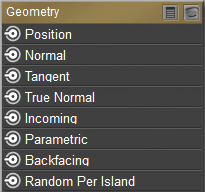
Cycles Geometry node.
Inputs:
None.
Outputs:
- Position: Position of the shading point.
- Normal: Shading normal at the surface (includes smooth normals and bump mapping)
- Tangent: Tangent at the surface.
- True Normal: Geometry or flat normal of the surface (does not include smooth normals or bump mapping)
- Incoming: Vector pointing towards the camera.
- Parametric: Parametric coordinates of the shading point on the surface.
- Backfacing: Output of 0 if the face is viewed from the front side, or 1 if the face is viewed from the back side.
- Random Per Island: A random value for each connected component (island) in the mesh. Adds variations to meshes that are composed of separated units, like tree leaves, wood planks, or curves of multiple splines.
HairInfo
This node gives access to strand hair information.
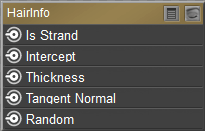
Cycles HairInfo node.
Outputs:
- Is Strand: Returns 1 when the shader is acting on a strand, otherwise returns 0.
- Intercept: The point along the strand where the ray hits the hair strand. Output is between 0 (when the ray hits the root) and 1 (when the ray hits the tip).
- Thickness: The thickness of the strand at the point where the ray hits the strand.
- Tangent Normal: Tangent normal of the strand.
- Random: A random per-hair value ranging from 0 to 1. Can be used in combination with a color ramp to randomize the hair color.
LayerWeight
Output weights typically used for layering shaders with the Mix Shader node.
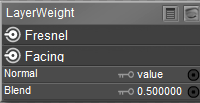
Cycles LayerWeight node.
Inputs:
- Normal: Connection for a normal map. If nothing is connected, the default normal shader will be used.
- Blend: The amount of blend between the first and second shader (0 for black, 1 for white). Lower values increase contrast.
Outputs:
- Fresnel: Like the Fresnel node, except that the input of this node is between the 0.0 to 1.0 range.
- Facing: Weight that blends from the first to the second shader as the surface faces or grazes the camera.
LightPath
Determines the kind of incoming light ray being executed. Useful for tricks that are not physically-based.
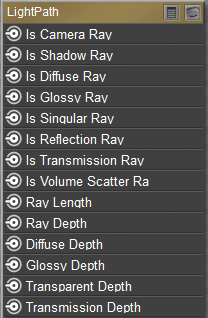
Cycles LightPath node.
Inputs:
None.
Outputs:
- Is Camera Ray: Output of 1.0 if shading is executed for a camera ray, otherwise output is 0.
- Is Shadow Ray: Output of 1.0 if shading is executed for a shadow ray, otherwise output is 0.
- Is Diffuse Ray: Output of 1.0 if shading is executed for a diffuse ray, otherwise output is 0.
- Is Glossy Ray: Output of 1.0 if shading is executed for a glossy ray, otherwise output is 0.
- Is Singular Ray: Output of 1.0 if shading is executed for a singular ray, otherwise output is 0.
- Is Reflection Ray: Output of 1.0 if shading is executed for a reflection ray, otherwise output is 0.
- Is Transmission Ray: Output of 1.0 if shading is executed for a transmission ray, otherwise output is 0.
- Is Volume Scatter Ray: Output of 1.0 if shading is executed for a volume scatter ray, otherwise output is 0.
- Ray Length: Distance traveled by the light ray from the last bounce or camera.
- Ray Depth: Returns the current light bounce.
- Transparent Depth: Returns the number of transparent surfaces passed through.
- Transmission Depth: Replace a Transmission light path after X bounces with another shader, (Diffuse, for example). Used to avoid black surfaces, due to low amount of max bounces.
ObjectInfo
Outputs information about the object instance. This can be useful for creating variations of a single material that is assigned to multiple instances. A Noise texture can give random colors, or a Color Ramp can give a range of colors to be randomly picked from.
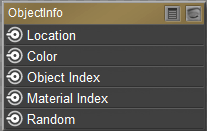
Cycles ObjectInfo node.
Inputs:
None.
Outputs:
- Location: World space location of the object.
- Color: The color of the object.
- Object Index: Object pass index.
- Material Index: Material pass index for each object that uses this material.
- Random: Random number between 0 and 1. Unique to a single object instance.
Tangent
Generates a tangent direction for the Anisotropic BSDF shader.

Cycles Tangent node.
Inputs:
- Direction: Radial projects the tangent in a cylindrical manner. UV Map allows you to choose any UV map that is compatible with the figure.
- Axis: For Radial direction only. Choose X (left to right), Y (up and down), or Z (back to front) axis.
Outputs:
- Tangent: The tangent direction vector.
TextureCoordinate
Commonly used texture coordinates, to be used as inputs for the Vector input for texture nodes.
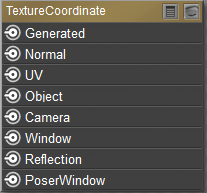
Cycles TextureCoordinate node.
Inputs:
None.
Outputs:
- Generated: Automatically-generated texture coordinates ranging from 0.0 to 1. 0 over the bounding box of the undeformed mesh
- Normal: Object space normal that stays fixed on the object as it transformed.
- UV: UV texture coordinates, with U corresponding to the X axis of 3D space and V corresponding to the Y axis in 3D space.
- Object: Position coordinate in object space.
- Camera: Position coordinate in camera space.
- Window: Location of shading point on the screen, ranging from 0.0 (for the left or bottom of the screen) to 1. 0 (for the right or top side of the screen).
- Reflection: Vector in the direction of a sharp reflection, typically used for environment maps
- Poser Window: Connect this output to a Vector input on the Cycles image node.
UVMap
Used to retrieve specific UV maps using the material.

Cycles UVMap node.
Inputs:
- From dupli:
Outputs:
- UV: UV texture coordinates, with U corresponding to the X axis of 3D space and V corresponding to the Y axis in 3D space.
Value
Outputs a constant value as specified. Useful when you need the same number as inputs for several different nodes.

Cycles Value node.
Inputs:
None.
Outputs:
- Value: Enter the desired numerical value to be output from the node.
Wireframe
Retrieve the edges of an object. Meshes are triangulated before being processed, so they will appear triangulated when viewed with the Wireframe node. Wires are white, everything else is black.

Cycles Wireframe node.
Inputs:
- Size: Thickness of edge lines.
- Pixel Size: Check this option to set the size of edge lines in screen space.
Outputs:
- Fac: A black and white mask showing white lines that represent edges according to the topology of the object.